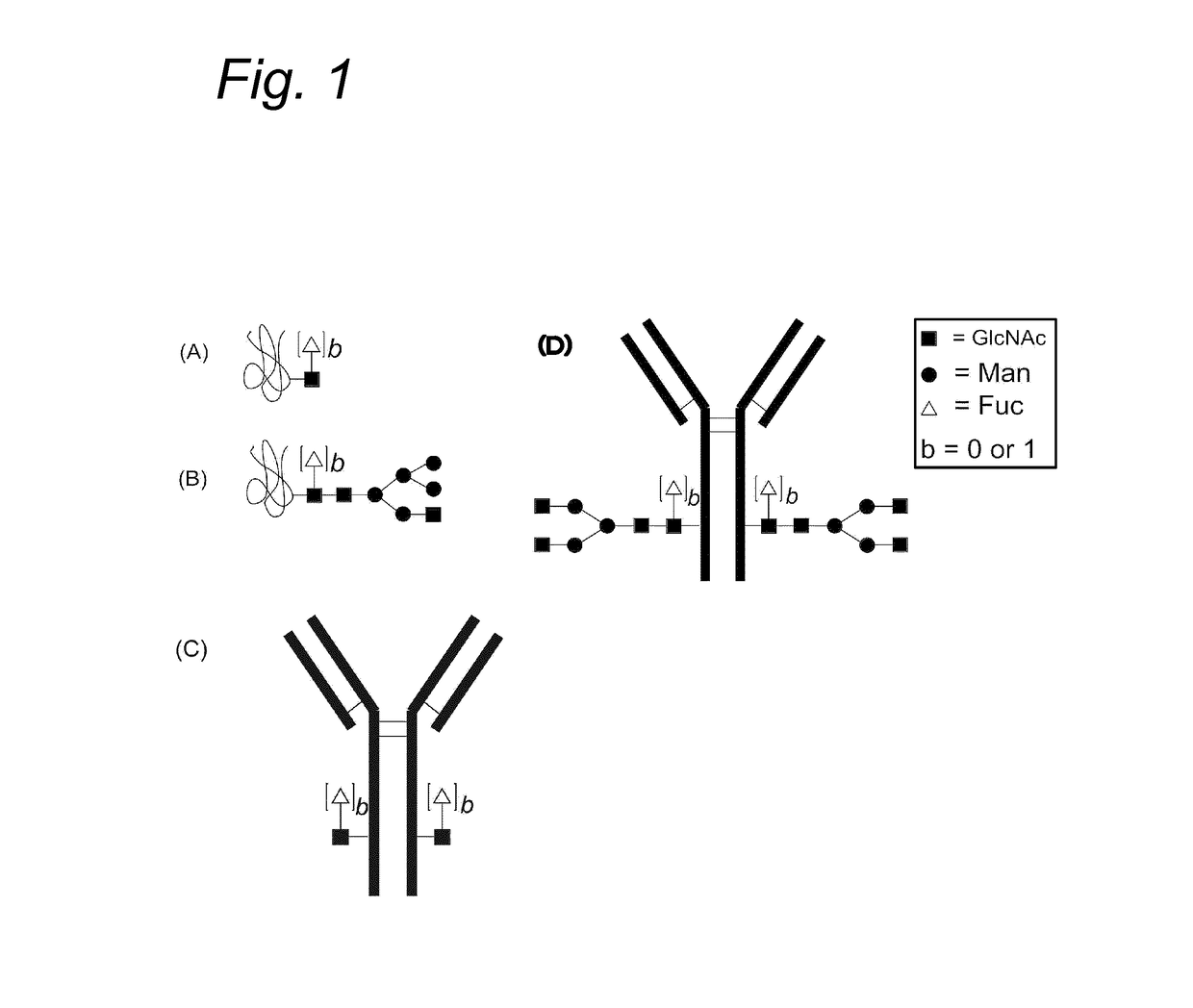Process for the modification of a glycoprotein using a glycosyltransferase that is or is derived from A β(1,4)-N-acetylgalactosaminyltransferase
- Summary
- Abstract
- Description
- Claims
- Application Information
AI Technical Summary
Benefits of technology
Problems solved by technology
Method used
Image
Examples
example 1
and Design of GalNAc-Transferases
[0555]Four specific sequences were selected for initial evaluation, in particular Uniprot accession number: Q9GUM2 (C. elegans; identified herein as SEQ ID NO: 2), U1MEV9 (A. suum; identified herein as SEQ ID NO: 3), Q6J4T9 (T. ni; identified herein as SEQ ID NO: 4) and Q7KN92 (D. melanogaster; identified herein as SEQ ID NO: 5). The polypeptides were constructed based on deletion of the predicted cytoplasmatic domain and transmembrane domain. These polypeptides comprise the predicted C. elegans (CeGalNAcT [30-383] identified by SEQ ID NO: 6), A. suum (AsGalNAcT [30-383] identified by SEQ ID NO: 7), T. ni (TnGalNAcT [33-421] identified by SEQ ID NO: 8) and D. melanogaster (DmGalNAcT [47-403] identified by SEQ ID NO: 9). In addition, polypeptide variants containing an N-terminal His-tag were constructed for AsGalNAcT [30-383] (His-AsGalNAcT [30-383] identified by SEQ ID NO: 71) and TnGalNAcT [33-421] (His-TnGalNAcT [33-421] identified by SEQ ID NO: 49...
example 3
cted Mutagenesis of his-TnGalNAcT(33-421) Mutants
[0558]A pET15b-vector containing the codon optimized sequence encoding residues 33-421 of TnGalNAcT (identified by SEQ ID NO: 8) between the NdeI-BamHI sites was obtained from Genscript, resulting in His-TnGalNAcT(33-421) (identified by SEQ ID NO: 49). The TnGalNacT mutant genes were amplified from the above described construct using a set of overlapping primers by a linear amplification PCR. The overlapping primer sets used for each mutant are shown in table 2. For the construction of His-TnGalNAcT(33-421; W336F) (identified by SEQ ID NO: 50) the DNA fragment was amplified with a pair of primers defined herein as SEQ ID NO: 79 and SEQ ID NO: 80. For the construction of His-TnGalNAcT(33-421; W336H) (identified by SEQ ID NO: 51) the DNA fragment was amplified with a pair of primers defined herein as SEQ ID NO: 81 and SEQ ID NO: 82. For the construction of His-TnGalNAcT(33-421; W336V) (identified by SEQ ID NO: 52) the DNA fragment was a...
example 5
Expression of GalNAcTs and Mutants in CHO
[0561]Proteins were transiently expressed in CHO K1 cells by Evitria (Zurich, Switzerland) at 20 mL scale. The following GalNAcT variants were expressed: CeGalNAcT(30-383) (identified by SEQ ID NO: 6), AsGalNAcT(30-383) (identified by SEQ ID NO: 7), TnGalNAcT(33-421) (identified by SEQ ID NO: 8), DmGalNAcT(47-403) (identified by SEQ ID NO: 9) and TnGalNAcT(33-421; E339A) (identified by SEQ ID NO: 28). In a typical purification experiment, CHO-produced supernatant containing the expressed GalNAcT was dialyzed against 20 mM Tris buffer, pH 7.5. The supernatant (typically 25 mL) was filtered through a 0.45 μM-pore diameter filter and subsequently purified over a cation exchange column (HiTrap SP HP 5 mL column, GE Healthcare), which was equilibrated with 20 mM Tris buffer, pH 7.5 prior to use. Purification was performed on an AKTA Prime chromatography system equipped with an external fraction collector. Samples were loaded from system pump A. Th...
PUM
| Property | Measurement | Unit |
|---|---|---|
| molecular weight | aaaaa | aaaaa |
| molecular weight | aaaaa | aaaaa |
| pH | aaaaa | aaaaa |
Abstract
Description
Claims
Application Information
 Login to View More
Login to View More - R&D
- Intellectual Property
- Life Sciences
- Materials
- Tech Scout
- Unparalleled Data Quality
- Higher Quality Content
- 60% Fewer Hallucinations
Browse by: Latest US Patents, China's latest patents, Technical Efficacy Thesaurus, Application Domain, Technology Topic, Popular Technical Reports.
© 2025 PatSnap. All rights reserved.Legal|Privacy policy|Modern Slavery Act Transparency Statement|Sitemap|About US| Contact US: help@patsnap.com



